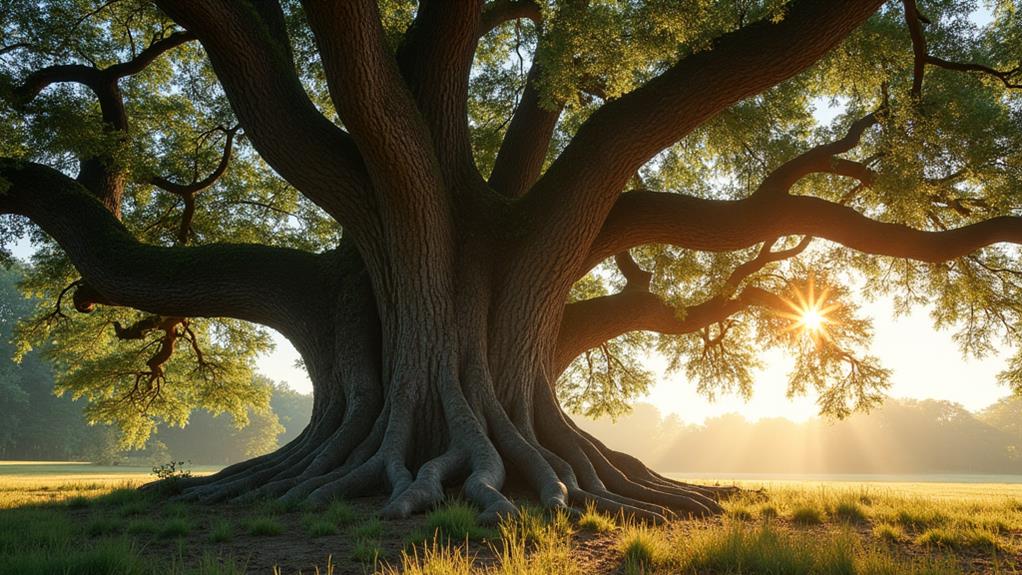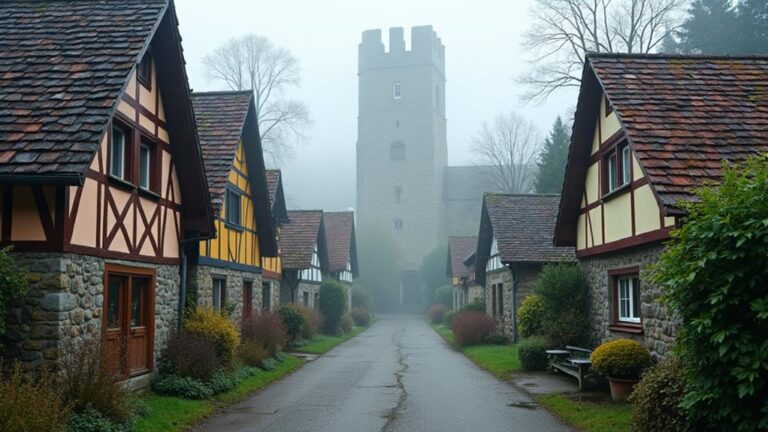You're probably familiar with famous landmarks like the Eiffel Tower or the Taj Mahal, but what about the world's most renowned trees? These ancient giants have witnessed history unfold and hold secrets of the past. From the estimated 1,500-year-old Angel Oak to the 2,000- to 2,500-year-old General Sherman Tree, these trees have stood the test of time. But what makes them so special, and what stories do they tell? As you explore the lives of these seven famous trees, you'll discover the fascinating histories and cultural significance that have made them an integral part of our collective heritage.
Contents
Key Takeaways
- The Angel Oak Tree is a 1,500-year-old tree in South Carolina, known for its massive size and resilience to natural disasters.
- The Major Oak Tree, located in Sherwood Forest, England, is an 800-1,100-year-old tree with a massive trunk and significant scientific importance.
- The Bodhi Tree in Bodh Gaya, India, is a sacred site marking the spot where Siddhartha Gautama achieved enlightenment, and is a UNESCO World Heritage site.
- The General Sherman Tree, located in Sequoia National Park, California, is a 2,000-2,500-year-old giant sequoia, and one of the largest trees by volume.
- The Grand Abuelo Tree, found in Chile, is estimated to be over 3,600 years old, and holds the record for the oldest living tree.
The Angel Oak Tree
The Angel Oak Tree, a southern live oak (Quercus virginiana) renowned for its massive size and age, is estimated to be around 1,500 years old.
You can appreciate its grandeur by considering its dimensions: it stands 66.5 feet tall, with a trunk circumference of 25.5 feet, and a canopy that covers 17,200 square feet.
The tree's age and size have contributed to its mystique, earning it a place in Oak Legends and folklore.
As you examine the tree's structure, you'll notice its sprawling canopy and extensive root system.
The Angel Oak Tree has survived numerous natural disasters, including hurricanes and floods.
Its ability to adapt to environmental stressors has allowed it to thrive for centuries.
The tree's remarkable resilience has led to its classification as a "champion tree" by the South Carolina Forestry Commission.
You can observe the tree's unique characteristics and appreciate its historical significance by visiting the Angel Oak Tree Park on Johns Island, South Carolina.
The Major Oak Tree
Standing in Sherwood Forest, Nottinghamshire, England, you find yourself before the Major Oak Tree, a pedunculate oak (Quercus robur) estimated to be around 800 to 1,100 years old.
This tree's age and size have led to it being considered one of the most famous trees in the English Countryside. As you approach the tree, you notice its massive trunk, which is supported by a series of wooden props to prevent collapse.
The tree's girth is approximately 33 feet (10 meters), and its canopy covers an area of about 92 feet (28 meters) in diameter.
As you examine the tree more closely, you observe that it's a remnant of a once-extensive forest ecosystem that has been largely cleared for agriculture and human settlement.
The Major Oak has been designated as a Site of Special Scientific Interest (SSSI) and is now protected by English Heritage and the Nottinghamshire County Council. Its longevity and ecological significance make it a valuable component of the English Countryside's natural heritage.
The tree's remarkable age has led to numerous scientific studies, which have contributed to a deeper understanding of tree ecology and conservation.
The Bodhi Tree
When you approach the Bodhi Tree, you're experiencing a site of immense historical significance, as it marks the location in Bodh Gaya, India, where Siddhartha Gautama, the founder of Buddhism, achieved enlightenment.
As you examine the tree's spiritual importance, consider its role as a symbol of the Buddha's attainment of Nirvana.
You'll find that the Bodhi Tree, a Ficus religiosa, has been revered for centuries as a sacred site, attracting pilgrims and scholars seeking to understand its enduring significance.
Historical Significance
Historically, you'll often find the Bodhi Tree mentioned in discussions about Buddhism, as it is the site where Siddhartha Gautama, the founder of Buddhism, achieved enlightenment under its canopy around 563 BCE. This event marks a pivotal moment in Buddhist history, as it's said to be the moment when Siddhartha Gautama became the Buddha, the "awakened one." The tree's historical significance extends beyond this singular event, as it has been a site of pilgrimage for centuries.
| Event | Date | Description |
|---|---|---|
| Siddhartha Gautama's Enlightenment | 563 BCE | Achieved enlightenment under the Bodhi Tree's canopy |
| Construction of the Mahabodhi Temple | 250 BCE | Emperor Ashoka built a temple to commemorate the site |
| Spread of Buddhism | 300 BCE – 500 CE | The Bodhi Tree became a site of pilgrimage for Buddhist monks |
| Preservation Efforts | 1881 CE | The British government initiated preservation efforts |
| UNESCO World Heritage Site Designation | 1986 CE | The Bodhi Tree was designated a UNESCO World Heritage site |
As you examine the history of the Bodhi Tree, you'll notice that it has ancient roots, with a rich history that spans over 2,500 years. Forest legends and historical accounts have contributed to the tree's significance, solidifying its place in Buddhist history.
Spiritual Importance
The Bodhi Tree's significance extends far beyond its historical roots, as it has become deeply ingrained in Buddhist spirituality.
You'll find that this tree is considered the site of Siddhartha Gautama's enlightenment, marking the birth of Buddhism. As a revered symbol, the Bodhi Tree's Sacred Canopy represents the unity of heaven and earth, while its Mystic Roots are said to have absorbed the wisdom and energy of the earth.
In Buddhist tradition, the Bodhi Tree is associated with the attainment of enlightenment.
According to scripture, the tree's canopy shielded the Buddha from external distractions, creating a conducive environment for meditation. Today, you'll find replicas of the Bodhi Tree in monasteries and temples worldwide, serving as focal points for spiritual growth and contemplation.
The tree's unique structure, with a broad canopy and extensive root system, is thought to represent the interconnectedness of all things. This concept is central to Buddhist teachings, emphasizing the importance of balance and harmony within the natural world.
The Treaty Oak Tree
Located in Jacksonville, Texas, you'll find the Treaty Oak Tree, a majestic Southern live oak estimated to be over 1,500 years old. As one of the oldest and largest trees in the United States, it's a popular tourist destination and a significant part of local history. According to tree legends, the Treaty Oak Tree was the site of a peace treaty between Native American tribes and early European settlers.
| Characteristics | Description |
|---|---|
| Age | Estimated to be over 1,500 years old |
| Species | Southern live oak (Quercus virginiana) |
| Height | Approximately 55 feet (16.8 meters) |
| Circumference | Over 64 feet (19.5 meters) |
| Canopy | Covers over 1 acre (0.4 hectares) |
The Treaty Oak Tree has become a symbol of peace and resilience, withstanding centuries of harsh weather conditions and human impact. Oak myths surrounding the tree's age and significance have contributed to its fame, attracting visitors from around the world. Scientific analysis has confirmed the tree's remarkable age, making it a valuable cultural and ecological resource.
The General Sherman Tree
In the heart of Sequoia National Park in California, you'll encounter the General Sherman Tree, a giant among giants that stands as the world's largest tree by volume, with an estimated age of 2,000 to 2,500 years.
This massive sequoia (Sequoiadendron giganteum) is a monument to the incredible resilience of forest giants.
To paint a picture of this natural wonder, consider the following key statistics:
- Height: The General Sherman Tree stands at an impressive 274.9 feet (84.1 meters) tall.
- Trunk diameter: Its trunk diameter measures 36.5 feet (11.1 meters), highlighting the tree's enormous girth.
- Volume: With an estimated volume of 52,508 cubic feet (1,487 cubic meters), this tree is a behemoth among its peers.
Effective tree care has contributed substantially to the General Sherman Tree's longevity.
Sequoia National Park's conservation efforts have protected this tree from human activities like logging and development.
The Grand Abuelo Tree
You're now turning your attention to the Grand Abuelo Tree, a Patagonian cypress located in Chile's Alerce Costero National Park.
As you examine this ancient tree, you'll discover that its age and history are remarkable, with estimates suggesting it's over 3,600 years old.
You'll also notice unique features, such as its trunk's distinctive shape and size, which set it apart from other trees in the same species, making it an ideal subject for further study and exploration.
Age and History
Spanning over 3,000 years of history, the Grand Abuelo tree stands as one of the oldest and most revered trees in the world, its age verified through radiocarbon dating and dendrochronology.
You can imagine the countless seasons this tree has endured, its ancient roots digging deeper into the earth as the years pass.
The tree's remarkable age is a legacy to its resilience and ability to adapt to changing environments.
As you examine the Grand Abuelo tree, you'll notice the visible signs of its age, particularly in its tree rings.
These rings provide a chronological record of the tree's growth, with each ring representing one year of growth.
The width and characteristics of the rings can reveal information about past environmental conditions, such as droughts, floods, and temperature fluctuations.
- Verified age: Radiocarbon dating and dendrochronology have confirmed the tree's age, making it one of the oldest living organisms on Earth.
- Ancient roots: The tree's root system is estimated to be over 2,000 years old, with some roots extending as deep as 10 meters underground.
- Growth patterns: The tree's growth patterns, as revealed by its tree rings, provide valuable insights into past environmental conditions and the tree's ability to adapt to changing circumstances.
Unique Features Found
The Grand Abuelo tree's remarkable age and growth patterns, as evidenced by its tree rings, are just a few aspects of its unique characteristics.
As you examine the tree, you'll notice its famous roots, which have grown in a unique pattern that allows the tree to thrive in its environment. The tree's root system has developed a symbiotic relationship with the surrounding ecosystem, enabling it to absorb nutrients more efficiently.
This adaptation is likely a result of its age and the tree's ability to evolve over time.
Tree legends often surround the Grand Abuelo, with many attributing its longevity to its unique characteristics.
The tree's ability to resist disease and pests is likely due to its genetic makeup, which has been shaped by centuries of natural selection. As you study the tree's morphology, you'll notice its distinctive shape, which is a result of its response to environmental pressures.
The Grand Abuelo's unique features have allowed it to become one of the most famous trees in the world, attracting scientists and tree enthusiasts alike. Its remarkable characteristics continue to inspire research and fascination.
Visiting the Tree
Visiting the Grand Abuelo Tree requires adherence to established guidelines to guarantee both visitor safety and tree well-being.
Upon arriving at the Grand Abuelo tree's location, visitors will need to follow these guidelines to minimize their impact on the tree and its surroundings.
To facilitate a safe and enjoyable experience, visitors are advised to observe the following tree etiquette and tree navigation guidelines:
- Stay on designated trails: Avoid taking shortcuts or venturing off marked pathways to prevent soil compaction and root damage.
- Maintain a safe distance: Keep a minimum of 3 meters (10 feet) from the tree trunk to prevent accidental damage or touching, which can transfer pathogens to the tree.
- Avoid removing plant material: Refrain from picking leaves, branches, or other plant material, as this can harm the tree and disrupt the ecosystem.
The Dragon Tree
Fascination with the Dragon Tree dates back centuries, as you explore into the world of botany. Native to the Canary Islands, this ancient tree has been the subject of many Dragon legends. The Dragon Tree, scientifically known as Dracaena draco, is a unique and fascinating species that has captured the imagination of botanists and enthusiasts alike.
| Characteristics | Description |
|---|---|
| Family | Asparagaceae |
| Genus | Dracaena |
| Species | D. draco |
| Distribution | Canary Islands, Cape Verde |
| Height | Up to 20 meters |
As you examine the Dragon Tree, you notice its distinctive umbrella-shaped canopy and thick, grey trunk. The tree's red sap, which resembles blood, has led to many Dragon legends and myths. The Dragon Tree is a slow-growing species, taking up to 100 years to reach maturity. Its unique characteristics make it a popular subject of study in the field of botany. By understanding the Dragon Tree, you gain insight into the natural world and the importance of preserving unique species.
Frequently Asked Questions
How Are Trees Protected From Natural Disasters?
You implement early warning systems to detect natural disasters, and consider investing in tree insurance policies to mitigate financial losses. These proactive measures enable you to protect trees from damage, ensuring their longevity and ecological integrity.
Can I Plant a Tree in My Backyard From These Species?
You can plant a tree in your backyard by sourcing species from a reputable tree nursery, ensuring compatibility with your local climate and soil conditions, and consulting private landscaping experts for proper installation and care.
What Is the Average Lifespan of These Famous Trees?
Planting a tree in your backyard is like giving birth to a legacy. You're likely wondering about its lifespan. Trees with ancient roots, like those with deep taproots and wide canopies, exhibit impressive longevity, often living hundreds to thousands of years.
How Do Trees Adapt to Different Environmental Conditions?
You observe that trees adapt to varying environments by developing drought tolerance through deep roots and cold hardiness through antifreeze proteins and physical changes, enabling them to survive extreme temperatures and water scarcity.
Can Famous Trees Be Cloned or Propagated Artificially?
You can attempt to clone or propagate famous trees artificially, but verifying their identity requires genetic fingerprinting to guarantee a precise match. This method helps confirm the tree's genetic makeup, preserving its unique characteristics.
Conclusion
You've explored the lives of seven iconic trees that have stood the test of time. These ancient trees have witnessed history unfold, and it's astonishing to think that the Grand Abuelo Tree has seen over 3,600 years of human civilization. Consider this: it's estimated that only about 0.1% of trees live beyond 1,000 years, making these trees truly exceptional and a monument to the resilience of nature.









